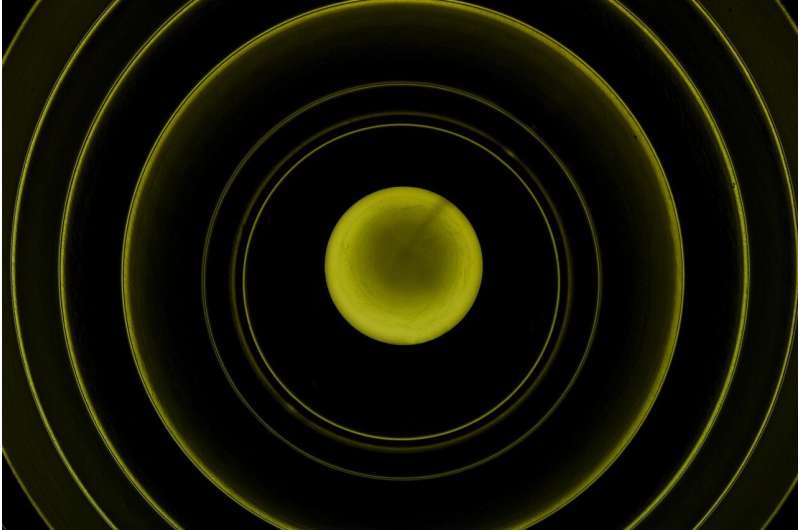Credit: Pixabay/CC0 Public Domain
Recently, a research team led by Dr.Li Yan from the Yunnan Observatories of the Chinese Academy of Sciences proposed a new means to explore the small-scale magnetic fields in the solar atmosphere through analyzing the frequencies of the solar p-mode oscillations, and found that the small-scale magnetic canopies can form a globally splicing layer in the solar photosphere, which has not been recognized before. The results were online published in the Astrophysical Journal.
In 1962, Leighton et al. found numerous oscillations of periods around five minutes on the solar photosphere. Observations and theoretical studies have shown that these oscillations are the eigenmodes of solar global oscillations similar to standing sound waves, and referred to as the solar p-mode oscillations.
Previous studies on the solar p-mode oscillations show that the calculated frequencies based on the standard solar models deviate systematically from the observed frequencies of the corresponding oscillation modes, and the largest frequency deviation can be 20 μHz.
Since the physical structure near the surface of the sun affects the high-frequency oscillation mode more than the low-frequency one, this systematic deviation is known as the near-surface effect. Recent studies suggested that the effect of turbulent convection on the physical structure around the solar photosphere might be responsible for this near-surface effect. Stellar models considering the effect of turbulent convection can reduce the maximum deviation to about 3 μHz.
The small-scale magnetic fields in the quiet region of the solar disk are an important constitution of the solar magnetic field. Due to their small sizes, they cannot be seen in the common solar magnetograms, and are often referred to as "hidden magnetic fields." The Solar Optical Telescope observations aboard the Hinode satellite show that the horizontal component has an averaged strength of about 55 gauss and the vertical component has a typical strength of about 11 gauss.
3D magneto-hydrodynamic simulations show that the convective motion can push the formerly uniformly distributed magnetic field upward, resulting in the formation of horizontally magnetic ribbons at a height 400~500 kilometer above the base of the photosphere. These magnetic ribbons are sometimes referred to as the "small-scale magnetic canopy."
In this work, the researchers introduced the magnetic fields and the magnetic pressure into the model of the solar atmosphere, and examined its effect on the propagation of the solar p-mode oscillations in the solar atmosphere by adjusting the location of the magnetic field and the magnitude of the magnetic pressure.
It is found that the small-scale magnetic canopies revealed by the three-dimensional numerical simulations cannot be randomly distributed in the solar atmosphere, but rather to be spliced together in the horizontal direction to form a small-scale magnetic canopy layer.
As a result, the magnetic field strength will increase when going cross this small-scale magnetic canopy layer, leading to a rapid rise in the magnetic pressure and the accompanying rapid decline in the gas pressure. The p-mode oscillation waves propagating from the interior of the sun will be totally reflected at this place, thus equivalently enlarging the cavity of the p-mode oscillations.
The researchers compared the theoretical frequencies of the p-mode oscillations with the observed frequencies of the corresponding modes, and found that the maximum deviation is only about 0.5 μHz, which is much better than the results given by other models. The inferred magnetic field intensity is about 90 gauss, which is consistent with the observed results.
At the same time, the height of the small-scale magnetic canopy layer deduced from the current model is about 630 kilometers high in the photosphere, which is consistent with the height of the small-scale magnetic canopy given by some three-dimensional numerical simulations.
The discovery of a small-scale magnetic canopy layer not only advances a big step toward finally solving the long-standing problem of the near-surface effect of the solar p-mode oscillations, but also provides a critical clue for further understanding of the physical structure of the solar photosphere and the origin of the solar magnetic fields.
More information: Yan Li et al, Can Small-scale Magnetic Fields Be the Major Cause for the Near-surface Effect of the Solar p-mode Frequencies?, The Astrophysical Journal (2021). DOI: 10.3847/1538-4357/ac0882
Journal information: Astrophysical Journal
Provided by Chinese Academy of Sciences
























